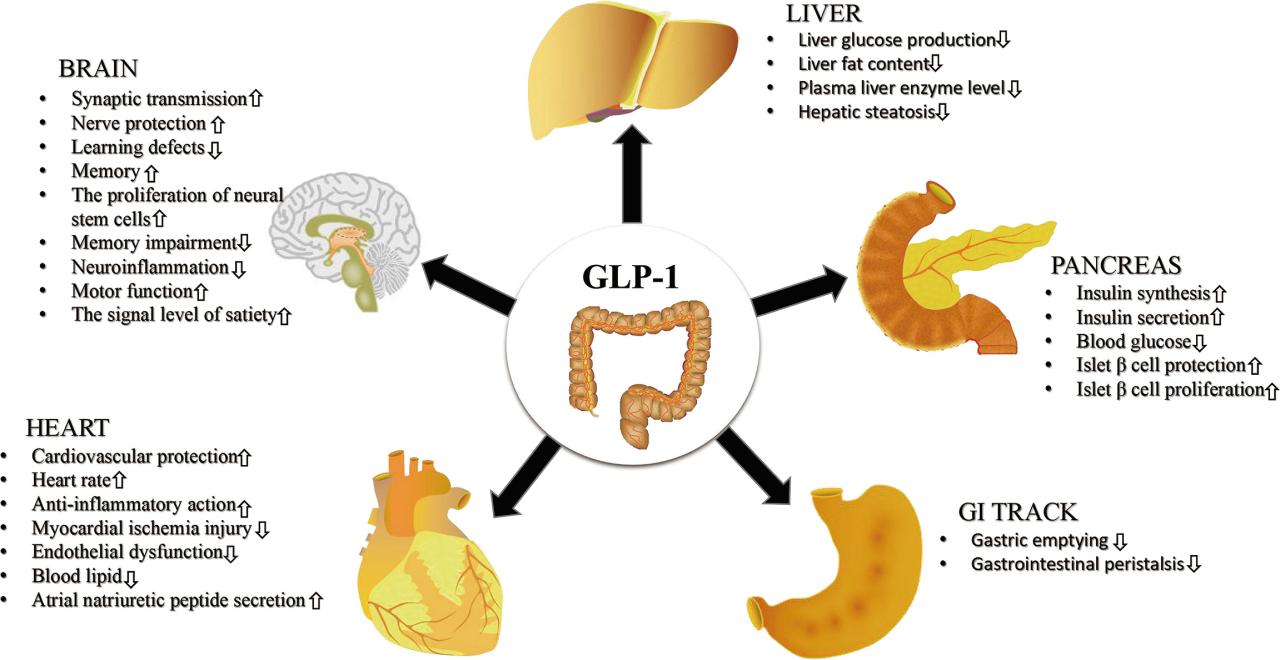
GLP-1s like Ozempic A Major Drug Breakthrough
Glp 1s like ozempic are among the most important drug breakthroughs ever – GLP-1s like Ozempic are among the most important drug breakthroughs ever, revolutionizing the treatment of type 2 diabetes and obesity. These medications, GLP-1 receptor agonists, work by mimicking a natural hormone that regulates blood sugar and appetite. Their impact extends far beyond simple blood sugar control; they’ve demonstrably improved patient outcomes, leading to significant weight loss and a reduction in cardiovascular complications.
This post delves into the science behind these groundbreaking drugs, their impact on healthcare, and what the future holds.
From their initial discovery to their current widespread use, GLP-1s have undergone a fascinating journey. This journey includes extensive research, clinical trials showcasing remarkable efficacy, and the subsequent impact on how we approach diabetes and obesity management. We’ll explore the mechanisms of action, compare them to older treatments, and discuss the broader economic and societal implications of their use.
Influence on Obesity Treatment

GLP-1 receptor agonists, like Ozempic (semaglutide) and Wegovy (semaglutide), have revolutionized the treatment of obesity and its related comorbidities. These medications represent a significant advancement beyond traditional weight-loss approaches, offering a powerful tool in combating a global health crisis. Their mechanism of action, coupled with demonstrable efficacy in clinical trials, positions them as a key player in the future of obesity management.GLP-1 receptor agonists work by mimicking the effects of glucagon-like peptide-1, a naturally occurring hormone that regulates appetite and glucose metabolism.
By binding to GLP-1 receptors in the brain and pancreas, these drugs promote satiety (feeling full), reduce food intake, and slow gastric emptying. This multifaceted action contributes to significant weight loss and improvements in associated metabolic conditions like type 2 diabetes and hypertension.
Weight Loss Outcomes in Clinical Trials
Numerous clinical trials have demonstrated impressive weight loss results with GLP-1 receptor agonists. For example, in the STEP trials evaluating semaglutide for chronic weight management, participants receiving the highest dose experienced an average weight loss of approximately 15-20% of their baseline weight over a period of 68 weeks. This level of weight loss is substantially greater than that typically achieved with lifestyle interventions alone.
The magnitude of weight loss observed underscores the potent effect of these medications on energy balance and body composition.
Comparison to Other Weight-Loss Interventions
GLP-1 receptor agonists offer a distinct advantage compared to other weight-loss strategies. While lifestyle modifications (diet and exercise) remain crucial, many individuals struggle to achieve significant and sustained weight loss through these methods alone. Bariatric surgery, although highly effective, is an invasive procedure with potential risks and complications. GLP-1 receptor agonists provide a less invasive and more accessible option for individuals who meet specific criteria, bridging the gap between lifestyle interventions and surgical approaches.
They can also be used in conjunction with lifestyle changes to maximize weight loss benefits.
Mechanism of Weight Loss: A Visual Representation
Imagine a diagram showing the human digestive system and brain. Arrows illustrate several key actions of GLP-1 receptor agonists:
1. In the gut
An arrow points from the medication to the stomach, indicating slowed gastric emptying. A smaller arrow points from the stomach to the brain, showing the delayed release of satiety signals.
2. In the brain
Arrows illustrate the binding of GLP-1 agonists to receptors in the hypothalamus, a brain region controlling appetite. This leads to increased satiety signals (represented by a larger, bolder arrow pointing from the hypothalamus to the appetite control center). Simultaneously, another arrow points from the hypothalamus to the food intake control center, indicating reduced appetite and food cravings.
3. In the pancreas
An arrow points from the medication to the pancreas, showing increased insulin secretion in response to food intake. This contributes to better glucose control and reduces the risk of hyperglycemia. Finally, a large arrow emerges from the combined effects in the gut, brain, and pancreas, pointing towards a smaller representation of a person, indicating overall reduced calorie intake and subsequent weight loss.
The overall image should be clean and easily understandable, emphasizing the multiple pathways involved in the weight-loss mechanism.
Economic and Societal Implications: Glp 1s Like Ozempic Are Among The Most Important Drug Breakthroughs Ever

The introduction of GLP-1 receptor agonists like Ozempic has sparked a significant debate extending beyond their impressive efficacy in managing type 2 diabetes and obesity. The economic and societal implications of these groundbreaking medications are far-reaching, demanding careful consideration of both their potential benefits and inherent challenges. While these drugs represent a major advancement in treatment, their high cost and potential for widespread adoption raise complex questions about healthcare access and affordability.The economic impact of GLP-1 receptor agonists is multifaceted.
Initial treatment costs are undeniably high, potentially straining healthcare budgets, particularly in systems with limited resources. However, long-term cost savings are also projected due to a reduction in complications associated with diabetes and obesity, such as cardiovascular events, kidney disease, and amputations. Studies are increasingly demonstrating that the preventative effects of these medications can outweigh the initial investment, leading to a net positive return for healthcare systems over the long term.
For instance, a reduction in hospitalizations for diabetic emergencies or cardiovascular events translates directly into substantial cost savings.
Healthcare System Costs and Savings, Glp 1s like ozempic are among the most important drug breakthroughs ever
Several studies have modeled the cost-effectiveness of GLP-1 receptor agonists. These models generally suggest that while the upfront cost of treatment is substantial, the long-term savings resulting from fewer complications and improved patient outcomes can lead to significant cost reductions for healthcare systems. The magnitude of these savings varies depending on factors such as the prevalence of diabetes and obesity in a given population, the baseline risk of complications, and the specific GLP-1 receptor agonist used.
However, the general trend points toward a potential for substantial long-term cost savings. For example, a reduction in the number of patients requiring dialysis due to diabetic nephropathy would represent a massive cost saving for the healthcare system. Similarly, a decrease in amputations related to diabetic foot ulcers would significantly reduce healthcare expenditure.
Societal Benefits of Improved Health Outcomes
Beyond the direct economic impact, the societal benefits stemming from improved health outcomes are considerable. Reduced rates of type 2 diabetes and obesity translate into a healthier, more productive workforce. Improved health and well-being enhance quality of life, leading to increased participation in social and economic activities. Moreover, the reduction in disability and premature mortality associated with these conditions can significantly reduce the burden on social support systems.
For instance, a healthier population requires fewer long-term care facilities and reduces the need for disability benefits. The overall societal benefit extends to families and communities, leading to a more vibrant and productive society.
Challenges of Widespread Adoption
The high cost of GLP-1 receptor agonists presents a significant barrier to widespread adoption. Accessibility and affordability are major concerns, particularly for individuals with limited insurance coverage or those in lower socioeconomic groups. This disparity in access could exacerbate existing health inequalities, creating a two-tiered system where only those with sufficient financial resources can benefit from these life-changing medications.
Furthermore, the long-term effects of widespread use and potential for side effects require ongoing monitoring and research. Ensuring equitable access and managing potential risks are crucial aspects of responsible implementation.
Policy Implications for GLP-1 Receptor Agonists
The widespread use of GLP-1 receptor agonists necessitates careful consideration of various policy implications. A balanced approach is needed to ensure both accessibility and fiscal responsibility.
- Negotiating lower drug prices: Governments could negotiate bulk purchasing agreements with pharmaceutical companies to reduce the cost of these medications.
- Expanding insurance coverage: Policies could be implemented to ensure wider insurance coverage for GLP-1 receptor agonists, particularly for individuals at high risk of developing complications from diabetes or obesity.
- Investing in preventative care: Greater investment in lifestyle interventions and preventative measures could reduce the long-term burden of diabetes and obesity, lessening the demand for expensive medications.
- Developing biosimilars: Encouraging the development and approval of biosimilar GLP-1 receptor agonists could increase competition and lower prices.
- Implementing cost-effectiveness analyses: Regular cost-effectiveness analyses should be conducted to evaluate the long-term economic impact of GLP-1 receptor agonists and inform healthcare resource allocation decisions.
The development and widespread adoption of GLP-1 receptor agonists like Ozempic mark a pivotal moment in the fight against type 2 diabetes and obesity. Their impact extends beyond individual health, influencing healthcare systems and societal well-being. While challenges regarding access and affordability remain, the potential for future advancements and broader applications is immense. These drugs represent not just a significant medical breakthrough, but a testament to the power of scientific innovation in improving lives on a global scale.
The ongoing research into GLP-1s promises even more effective and accessible treatments in the years to come.
Seriously, GLP-1s like Ozempic are revolutionary – a massive leap forward in diabetes treatment. It’s mind-blowing to consider the impact, especially when you compare it to other major news, like the ongoing situation at the border, where, as reported homeland security secretary alejandro mayorkas says he has no plans to resign amid border crisis. The contrast highlights how breakthroughs in medicine can quietly reshape lives, while other critical issues demand immediate attention.
GLP-1s like Ozempic are revolutionary; their impact on diabetes management is undeniable. This kind of pharmaceutical innovation highlights the increasing global competition in the healthcare sector, and it’s exciting to see how companies are responding, like those discussed in this article on chinese firms will keep going global. The future of drug development will likely involve even more international collaboration, ensuring continued breakthroughs like GLP-1s become more accessible worldwide.
Seriously, GLP-1s like Ozempic are game-changers; we’re talking about one of the most significant medical advancements in recent history. It’s a stark contrast to the frustrating narratives surrounding other health crises, like the one highlighted in this article about Fauci – fauci the master bureaucrat says its not his fault – which reminds us that progress isn’t always guaranteed.
The development of GLP-1s, however, shows what incredible things are possible when research and development are prioritized.


